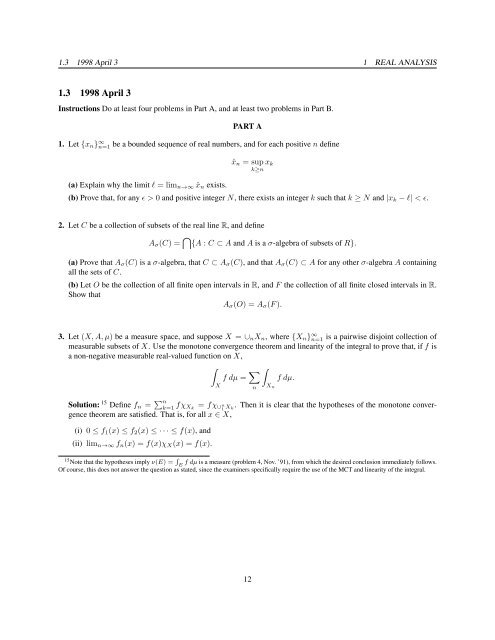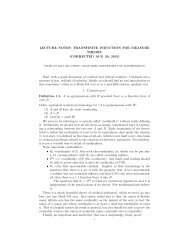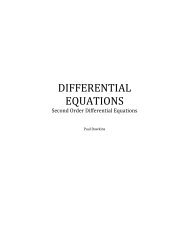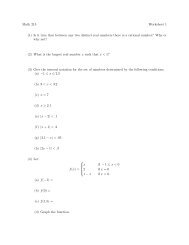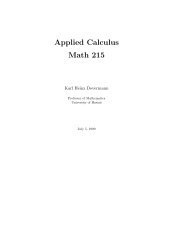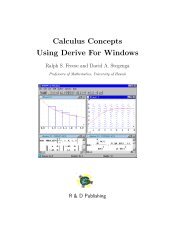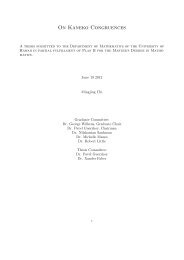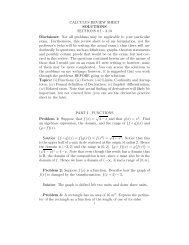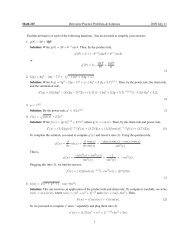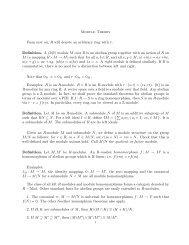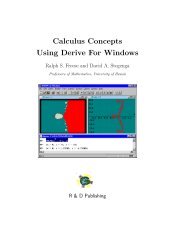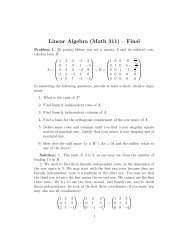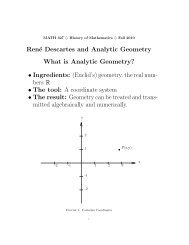Problems and Solutions in - Mathematics - University of Hawaii
Problems and Solutions in - Mathematics - University of Hawaii
Problems and Solutions in - Mathematics - University of Hawaii
You also want an ePaper? Increase the reach of your titles
YUMPU automatically turns print PDFs into web optimized ePapers that Google loves.
1.3 1998 April 3 1 REAL ANALYSIS<br />
1.3 1998 April 3<br />
Instructions Do at least four problems <strong>in</strong> Part A, <strong>and</strong> at least two problems <strong>in</strong> Part B.<br />
PART A<br />
1. Let {xn} ∞ n=1 be a bounded sequence <strong>of</strong> real numbers, <strong>and</strong> for each positive n def<strong>in</strong>e<br />
(a) Expla<strong>in</strong> why the limit ℓ = limn→∞ ˆxn exists.<br />
ˆxn = sup xk<br />
k≥n<br />
(b) Prove that, for any ɛ > 0 <strong>and</strong> positive <strong>in</strong>teger N, there exists an <strong>in</strong>teger k such that k ≥ N <strong>and</strong> |xk − ℓ| < ɛ.<br />
2. Let C be a collection <strong>of</strong> subsets <strong>of</strong> the real l<strong>in</strong>e R, <strong>and</strong> def<strong>in</strong>e<br />
Aσ(C) = {A : C ⊂ A <strong>and</strong> A is a σ-algebra <strong>of</strong> subsets <strong>of</strong> R}.<br />
(a) Prove that Aσ(C) is a σ-algebra, that C ⊂ Aσ(C), <strong>and</strong> that Aσ(C) ⊂ A for any other σ-algebra A conta<strong>in</strong><strong>in</strong>g<br />
all the sets <strong>of</strong> C.<br />
(b) Let O be the collection <strong>of</strong> all f<strong>in</strong>ite open <strong>in</strong>tervals <strong>in</strong> R, <strong>and</strong> F the collection <strong>of</strong> all f<strong>in</strong>ite closed <strong>in</strong>tervals <strong>in</strong> R.<br />
Show that<br />
Aσ(O) = Aσ(F ).<br />
3. Let (X, A, µ) be a measure space, <strong>and</strong> suppose X = ∪nXn, where {Xn} ∞ n=1 is a pairwise disjo<strong>in</strong>t collection <strong>of</strong><br />
measurable subsets <strong>of</strong> X. Use the monotone convergence theorem <strong>and</strong> l<strong>in</strong>earity <strong>of</strong> the <strong>in</strong>tegral to prove that, if f is<br />
a non-negative measurable real-valued function on X,<br />
<br />
f dµ = <br />
<br />
f dµ.<br />
X<br />
n<br />
Solution: 15 Def<strong>in</strong>e fn = n k=1 fχXk = fχ∪n 1<br />
Xk . Then it is clear that the hypotheses <strong>of</strong> the monotone convergence<br />
theorem are satisfied. That is, for all x ∈ X,<br />
(i) 0 ≤ f1(x) ≤ f2(x) ≤ · · · ≤ f(x), <strong>and</strong><br />
(ii) limn→∞ fn(x) = f(x)χX(x) = f(x).<br />
<br />
15Note that the hypotheses imply ν(E) = E f dµ is a measure (problem 4, Nov. ’91), from which the desired conclusion immediately follows.<br />
Of course, this does not answer the question as stated, s<strong>in</strong>ce the exam<strong>in</strong>ers specifically require the use <strong>of</strong> the MCT <strong>and</strong> l<strong>in</strong>earity <strong>of</strong> the <strong>in</strong>tegral.<br />
12<br />
Xn


